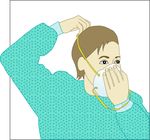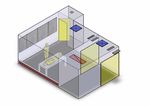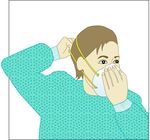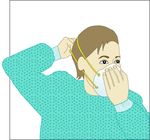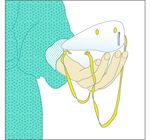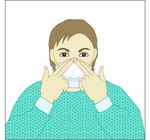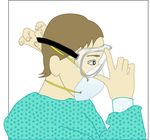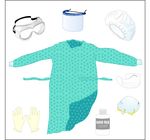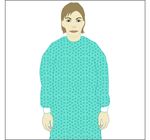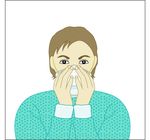Infection prevention and control of epidemic- and pandemic-prone acute respiratory diseases in health care - WHO Interim Guidelines
←
→
Page content transcription
If your browser does not render page correctly, please read the page content below
WHO/CDS/EPR/2007.6
Infection prevention and
control of epidemic- and
pandemic-prone acute
respiratory diseases in
health care
WHO Interim Guidelines
June 2007
EPIDEMIC AND PANDEMIC
ALERT AND RESPONSEInfection prevention and control of epidemic- and pandemic-prone acute respiratory diseases in health care WHO Interim Guidelines June 2007
Guidance updates
• The present guidelines supersede the document “Hospital Infection Control Guid-
ance for Severe Acute Respiratory Syndrome (SARS)”, revised 24 April 2003,
previously available at http://www.who.int/csr/sars/infectioncontrol/en/
• These guidelines relate to, and can be used in conjunction with, the document
“Avian Influenza, Including Influenza A (H5N1): WHO Interim Infection
Control Guidelines for Health-care Facilities” published by the WHO Regional
Office for the Western Pacific on 10 March 2004, and updated in May 2007,
available at http://www.who.int/csr/disease/avian_influenza/guidelines/
infectioncontrol1/en/index.htmll
• Please make sure the version being used is the most recent version available at:
http://www.who.int/csr/resources/publications/csrpublications/en/index7.html.
• After the conclusion of the pilot tests, to be conducted in 200/2008, a revised
version of these guidelines will be published.
• In the event of new epidemics or pandemics, additional recommendations will be
forthcoming.
© World Health Organization 2007
All rights reserved.
The designations employed and the presentation of the material in this publication do not imply the
expression of any opinion whatsoever on the part of the World Health Organization concerning the legal
status of any country, territory, city or area or of its authorities, or concerning the delimitation of its
frontiers or boundaries. Dotted lines on maps represent approximate border lines for which there may
not yet be full agreement.
The mention of specific companies or of certain manufacturers’ products does not imply that they are
endorsed or recommended by the World Health Organization in preference to others of a similar nature
that are not mentioned. Errors and omissions excepted, the names of proprietary products are distin-
guished by initial capital letters.
All reasonable precautions have been taken by the World Health Organization to verify the information
contained in this publication. However, the published material is being distributed without warranty of
any kind, either express or implied. The responsibility for the interpretation and use of the material lies
with the reader. In no event shall the World Health Organization be liable for damages arising from its
use.Infection prevention and control of epidemic- and pandemic-prone acute respiratory diseases in health care
WHO Interim Guidelines
Contents
Foreword................................................................................................................................3
Acknowledgements ...............................................................................................................4
I. List of acronyms and definition of terms used in the document ..................................5
II. Executive summary........................................................................................................10
III. Introduction and scope of the guidelines....................................................................12
III.1 ARDs in health care ...................................................................................................12
III.2 Scope of the current guidelines.................................................................................12
III.3 ARDs that may constitute a public health emergency of international concern
covered in the current document......................................................................13
III.3.1 Severe acute respiratory syndrome (SARS) ..................................................................... 13
III.3.2 New influenza virus causing human infection ................................................................. 13
III.3.3 Novel ARD with potential to have a high public health impact....................................... 13
III.4 Infection control guiding principles...........................................................................14
III.5 Environmental ventilation..........................................................................................15
IV. Infection prevention and control recommendations ................................................16
IV.1 Early recognition, isolation, reporting, and surveillance of episodes of ARD of
potential international public health concern ...........................................................16
IV.2 Administrative control strategies for HCFs...............................................................21
IV.2.1 Isolation precautions ........................................................................................................ 22
IV.2.2 Cohorting and special measures....................................................................................... 22
IV.2.3 Transport of patients inside and outside HCFs ................................................................ 23
IV.2.4 Duration of infection control precautions and patient discharge ..................................... 24
IV.2.5 Family member/visitor recommendations........................................................................ 25
IV.2.6 Specimen collection/transport/handling within HCFs ..................................................... 26
IV.2.7 Occupational health.......................................................................................................... 27
IV.3 Engineering and environmental control for ARDs...................................................28
IV.3.1 Placement of patients with ARDs .................................................................................... 28
IV.3.2 Design of triage and waiting areas ................................................................................... 29
IV.3.3 Corridors .......................................................................................................................... 29
IV.4 PPE use .....................................................................................................................29
IV.4.1 Rational use of PPE.......................................................................................................... 29
IV.5 Care of the deceased .................................................................................................31
IV.5.1 Removal of the body from the isolation room/area.......................................................... 31
–1–Infection prevention and control of epidemic- and pandemic-prone acute respiratory diseases in health care
WHO Interim Guidelines
IV.5.2 Mortuary care................................................................................................................... 31
IV.5.3 Postmortem examination.................................................................................................. 31
IV.5.4 Engineering and environmental controls for autopsy ...................................................... 32
V. Environmental ventilation for respiratory infections................................................33
V.1 General concepts and principles ................................................................................34
V.2 Use of natural ventilation in isolation rooms .............................................................35
V.3 Use of exhaust fans in isolation rooms ......................................................................38
V.4 Use of mechanical ventilation in isolation rooms......................................................38
V.5 Conclusions................................................................................................................39
VI. HCF preparedness planning for ARD epidemics ......................................................40
Annex A. Respiratory protection ......................................................................................43
Annex B. Principles and design of natural ventilation .....................................................48
Annex C. Routine and specific infection control precautions ..........................................53
Annex D. Sample checklist assessment of environmental conditions for home care of
patients with ARDs of potential concern .........................................................60
Annex E. Sample HCW influenza-like illness monitoring form for HCW exposed to
patients with ARDs of potential concern .........................................................61
Annex F. Isolation rooms/areas .......................................................................................62
Annex G. Mortuary care and postmortem examination....................................................67
Annex H. Use of disinfectants: alcohol and bleach ..........................................................69
Annex I. Surge capacity: HCF PPE needs during epidemics/pandemics .........................71
Annex J. Cleaning and disinfection of respiratory equipment..........................................74
Annex K. Infection control across the continuum of health care .....................................76
References............................................................................................................................79
–2–Infection prevention and control of epidemic- and pandemic-prone acute respiratory diseases in health care
WHO Interim Guidelines
Foreword
The purpose of this document is to provide infection control guidance to help prevent the transmission
of acute infectious respiratory diseases during health care, with emphasis on acute respiratory diseases
that may constitute a public health emergency of international concern as defined in the International
Health Regulations (2005; Annex 1). Managers of health-care facilities may also consider using this
guidance to assist them in preparation for epidemics and pandemics.
This document is intended to be used by government planners, health-care facility administrators,
infection control professionals, occupational health specialists, other professionals involved in patient
care and direct care providers.
The infection control advice provided in the guidelines is based on available information on the main
routes of transmission of pathogens, and is intended to provide guidance for continuous and
sustainable improvement in safety of health care. These guidelines are designed to offer Member
States a conceptual framework for individual adaptation according to local regulations, settings, needs
and resources. Health-care facilities are encouraged to review the recommendations and to adapt them
accordingly.
The guidelines were developed after performing a systematic review of the scientific literature (in
English) identified through PubMed (US National Library of Medicine) and the Cochrane Library,
and secondary papers (in English, and also in Chinese, French, Portuguese and Spanish) identified
from existing relevant guidelines. International and national infection control guidelines and infection
control textbooks were also consulted. The document has undergone internal and external peer
reviews. The Guideline Steering Group1 evaluated the comments suggested by the reviewers
providing guidance when opinions differed, and oversaw the incorporation of amendments and
finalization of the document.
Pilot tests of the guidelines will be conducted in 2007 and 2008 in each of the six WHO Regions to
help provide local data on clarity of the document and generate information on resources required to
carry out the recommendations, feasibility, and validity of the interventions concerned. The pilot tests
may also help provide information for implementation and dissemination strategies. The guidelines
will be reviewed and updated after the conclusion of the pilot tests.
As in many other areas, the knowledge on modes of transmission of respiratory diseases is evolving
rapidly. In addition, case surveillance and case and contact investigation are critical in defining and
identifying changes in the epidemiology of human infections and will continue to inform infection
control recommendations. Modifications to these guidelines will be made, as necessary, as additional
information becomes available.
1
Guideline Steering Group: Denise Mary Cardo, CDC, Atlanta, USA; Cathryn Murphy, Infection Plus, Australia; Fernando Otaiza,
Ministry of Health, Chile; Shirley Paton, Public Health Agency, Canada; Carmem L Pessoa-Silva, WHO/EPR; Cathy Roth, WHO/EPR
Wing-Hong Seto, Queen Mary Hospital, China, Hong Kong SAR. All external experts have signed the declaration of interests in
accordance with WHO policy and are available on request.
–3–Infection prevention and control of epidemic- and pandemic-prone acute respiratory diseases in health care
WHO Interim Guidelines
Acknowledgements
This document is the product of collaborative efforts across WHO, led by the Department of
Communicable Disease Surveillance and Response at the WHO Regional Office for the Western
Pacific and the Department of Epidemic and Pandemic Alert and Response at WHO Headquarters,
with significant input from the staff at other WHO regional offices, and from many partners working
in collaboration with WHO worldwide.
WHO wishes to thank the Department of International Cooperation of Italy’s Ministry of Foreign
Affairs, the Swiss Humanitarian Aid Agency of the Federal Department of Foreign Affairs, the Alfred
P. Sloan Foundation, the United States Centers for Disease Control and Prevention, and the United
States Agency for International Development for their generous financial support for the development
and publication of this document.
WHO wishes to acknowledge with gratitude the commitment of experts from all over the world who
contributed to the preparation of this document:
Michael Bell, Maureen Birmingham, Denise Mary Cardo, Mary Chamberland, Yves Chartier, Patricia
Ching, Gerald Dziekan, Ana Estrela, Pierre Formenty, Keiji Fukuda, Paul Gully, Kathleen Harriman,
Frederick Hayden, Suzanne Hill, Stéphane Hugonnet, William R Jarvis, Dominique Legros, Yuguo Li,
Marlo Libel, Jose C Martines, Ziad A Memish, Sylvie Mortier, Cathryn Murphy, Fernando Otaiza,
Ulysses Panisset, Shirley Paton, Carmem L Pessoa-Silva, Nicoletta Previsani, Sue Resnik, Guenaël
RM Rodier, Victor D Rosenthal, Cathy Roth, Michael J Ryan, Sharon Salmon, Wing-Hong Set, Nikki
Shindo, Gail Thomson, Teresa KF Wang, Martin W Weber, Susan Wilburn, Rosamund Williams.
Editors
Carmem L Pessoa-Silva, Wing-Hong Seto.
Writing committee
(responsible for drafting and finalizing the document)
Patricia Ching, Kathleen Harriman, Yuguo Li, Carmem L Pessoa-Silva, Wing-Hong Seto, Teresa KF
Wang.
Guideline steering group
(responsible for overseeing the process of developing the document)
Denise Mary Cardo, Cathryn Murphy, Fernando Otaiza, Shirley Paton, Carmem L Pessoa-Silva,
Cathy Roth, Wing-Hong Seto.
External peer review board
(experts responsible for external technical review)
Michael Bell, Mary Chamberland, Stéphane Hugonnet, William R Jarvis, Ziad A Memish, Sue Resnik,
Victor D Rosenthal.
Administrative and secretarial support
Sylvie Mortier
Technical editing
Rosamund Williams
–4–Infection prevention and control of epidemic- and pandemic-prone acute respiratory diseases in health care
WHO Interim Guidelines
I. List of acronyms and definition of terms used in the
document
Acronyms
ACH air changes per hour
AORN Professional Organization of Perioperative Registered Nurses (USA)
ARD acute respiratory disease
ASTM American Society for Testing and Materials (former name)
BFE bacterial filtration efficiency
BiPAP bilevel positive airway pressure
BSL biosafety level
CDC(US) Centers for Disease Control and Prevention, Atlanta, United States of America
CE Conformité Européenne (European Conformity)
Co-V coronavirus
CPAP continuous positive airway pressure
EU European Union
FDA Food and Drug Administration (United States of America)
FFP filtering face piece
HCF health-care facility
HCW health-care worker
HVAC heating, ventilation, and air conditioning
IHR International Health Regulations
ILI influenza-like illness
NIOSH(US) National Institute for Occupational Safety and Health
OR operating room
PFE particulate filtration efficiency
PPE personal protective equipment
ppm parts per million
RSV respiratory syncytial virus
RT-PCR reverse transcription polymerase chain reaction
SARS severe acute respiratory disease
SIGN(WHO) Safe Injection Global Network
WHO World Health Organization
–5–Infection prevention and control of epidemic- and pandemic-prone acute respiratory diseases in health care
WHO Interim Guidelines
Definitions of terms
The following terms have been defined for the purpose of this document.
Acute respiratory diseases
Acute respiratory diseases (ARDs) are upper or lower respiratory tract illnesses, usually infectious in
etiology, which can result in a spectrum of illnesses ranging from asymptomatic or mild infection to
severe and fatal disease, depending on the causative pathogen, environmental, and host factors.
However, for the purposes of this document, an ARD is defined as an acute respiratory tract illness
that is caused by an infectious agent transmitted from person to person. The onset of symptoms is
typically rapid, over a period of hours to several days. Symptoms include fever, cough, and often sore
throat, coryza, shortness of breath, wheezing, or difficulty breathing. Examples of pathogens causing
ARDs included in these guidelines are rhinovirus, respiratory syncytial virus, parainfluenza virus,
severe acute respiratory syndrome-associated coronavirus (SARS-CoV) and influenza virus.
Acute respiratory diseases of potential concern
Acute respiratory diseases of potential concern (ARDs of potential concern) refer to 1- SARS-CoV
(see section III.1) 2- new influenza virus causing human infection (see section III.2); and 3- novel
ARDs that can cause large-scale outbreaks and outbreaks with high morbidity and mortality (see
section III.3).
Adequately ventilated single room
A single room, or a side room in the ward, with ≥ 12 air changes per hour (ACH) without controlled
direction of air flow.
Aerosol-generating procedures associated with pathogen transmission
Procedures that have been reported to be aerosol-generating and associated with a documented
increased risk of pathogen transmission. These include intubation and related procedures,
cardiopulmonary resuscitation, bronchoscopy, autopsy and surgery where high-speed devices (e.g.
saw) are used (see Annex A for details).
Airborne precaution room
An airborne precaution room is a room with ≥ 12 air changes per hour (ACH) and controlled direction
of air flow, and can be used to contain airborne infections (1-3) and ARDs caused by a novel agent
with the potential to have a high public health impact. An airborne precaution room can be naturally
or mechanically ventilated. In addition to the requirement of ≥ 12 ACH, in a mechanically ventilated
airborne precaution room, negative pressure is created to control the direction of air flow. It is
equivalent to the “airborne infection isolation room” described by the United States Centers for
Disease Control and Prevention (CDC)(4). In naturally ventilated airborne precaution rooms the air
flow should be directed to areas free of transit, or permit the rapid dilution of contaminated air into the
surrounding areas and the open air. For details of airborne precaution rooms, refer to section V and
Annex B.
Airborne transmission
Airborne transmission of infectious agents refers to the transmission of disease caused by
dissemination of droplet nuclei that remain infectious when suspended in air over long distance and
time. Airborne transmission can be further categorized into obligate or preferential airborne
transmission(5).
Obligate airborne transmission refers to pathogens that are transmitted only by deposition of droplet
nuclei under natural conditions (e.g. pulmonary tuberculosis).
Preferential airborne transmission refers to pathogens that can initiate infection by multiple routes,
but are predominantly transmitted by droplet nuclei (e.g. measles, chickenpox).
–6–Infection prevention and control of epidemic- and pandemic-prone acute respiratory diseases in health care
WHO Interim Guidelines
Air changes per hour (ACH)
Volume of air moved in one hour. One air change per hour in a room, home, or building means that
all the air in that environment will be replaced in one hour (6).
Alcohol-based hand rub
An alcohol-containing preparation designed for application to the hands for hand antisepsis.
Anteroom
A small room leading from a corridor into another room, often an isolation room.
Caregiver
A person who provides support and assistance, formal or informal, with various activities to people
with disabilities or long-term conditions, or elderly people. This person may provide emotional or
financial support, as well as hands-on help with different tasks (7).
Cleaning
The removal of dirt from a device or surface, using either the physical action of scrubbing with a
surfactant or detergent and water, or an energy-based process (e.g. ultrasonic cleaners) with
appropriate agents.
Clinical waste
Also known as infectious waste, it refers to hazardous waste capable of causing infections in humans.
This includes: contaminated animal waste; human blood and blood products; waste from isolation
areas; pathological waste (e.g. human tissues); and discarded sharps (needles, scalpels or broken
medical instruments). The definition may vary depending on local legislations and regulations.
Cohorting and special measures
Cohorting refers to placing patients infected or colonized with the same known pathogen in the same
designated unit (same space and staff in the unit) to which patients without the pathogen are not
admitted.
Special measures refer to the placing of patients with the same suspected diagnosis (similar
epidemiological and clinical information) in the same unit, but when the etiological agent is not yet
laboratory-confirmed.
Contact transmission
Contact transmission can be direct and indirect. Direct contact transmission involves both a direct
body surface to body surface contact and physical transfer of microorganisms between an infected or
colonized person and a susceptible host. Indirect contact transmission involves contact of a
susceptible host with a contaminated intermediate object (e.g. contaminated hands), that carry and
transfer the microorganisms (3).
Disinfection
A process that eliminates all pathogenic microorganisms, with the exception of bacterial spores, from
inanimate objects, for the purpose of minimizing risk of infection.
Droplet transmission
Droplets are generated from an infected (source) person primarily during coughing, sneezing, and
talking. Transmission occurs when these droplets containing microorganisms are propelled a short
distance (usually < 1m) through the air and deposited on the conjunctivae, mouth, nasal, throat or
pharynx mucosa of another person. Because droplets do not remain suspended in the air, special air
handling and ventilation are not required to prevent droplet transmission (3).
Environmental mechanical ventilation
Use of mechanical fans to introduce and distribute outdoor and/or properly treated recycled air into a
building or a room.
–7–Infection prevention and control of epidemic- and pandemic-prone acute respiratory diseases in health care
WHO Interim Guidelines
Environmental natural ventilation
Natural ventilation uses natural forces to introduce and distribute outdoor air into a building. These
natural forces can be wind pressure or pressure generated by the density difference between indoor
and outdoor air.
Hand hygiene
A general term that applies to hand washing, antiseptic hand washing, antiseptic hand rubbing, or
surgical hand antisepsis.
Health-care facility
Any establishment that is engaged in direct patient care on site(7).
Health-care setting
Clinical context where health care is provided (e.g. hospital, outpatient clinic, home).
Health-care worker
A variety of professionals (medical practitioners, nurses, physical and occupational therapists, social
workers, pharmacists, spiritual counsellors, etc) who are involved in providing coordinated and
comprehensive care (7).
Health personnel
All persons employed or contracted to provide health services (7).
Human influenza
An acute contagious viral infection, commonly occurring in seasonal epidemics (seasonal influenza)
or rarely pandemics (pandemic influenza), characterized by inflammation of the respiratory tract, and
typically manifested by the sudden onset of fever, chills, muscular pain, severe prostration, sore throat,
and cough (8). Transmission of infection occurs at close range, mainly through droplets and
occasionally through contact. To date, there is a lack of evidence to suggest that the infection is
airborne-transmitted among humans in health-care settings(9).
Infectious respiratory aerosols
Respiratory aerosols which contain infectious particles. Aerosol size is determined by the force and
pressure involved in the generation of the particles. The final size depends on the nature of the fluid
containing the organism(s), the force and pressure at emission, the initial size of the aerosol,
environmental conditions (e.g. temperature, relative humidity, and air flow), the time spent airborne,
and the size of the organism(s) within a droplet. The distance and length of time particles remain
suspended in the air is determined by the types of organisms, particle size, settling velocity, relative
humidity and air flow. Large particles typically remain suspended in the air for limited period of time
and settle within 1 m (3 feet) of the source. Smaller particles evaporate quickly, and the resulting
dried residues settle from the air slowly, and may remain suspended in the air for variable lengths of
time. The definitions and classification of the different types of infectious respiratory aerosols are
evolving, and the implications for the infection control measures are not yet clear. However, for the
purpose of this document, infectious respiratory aerosols will be classified into:
Droplets: Respiratory aerosols > 5 µm in diameter.
Droplet nuclei: Respiratory aerosols ≤ 5 µm in diameter.
Medical mask
A surgical or procedure mask protecting caregivers against droplet-transmitted pathogens and/or as
part of facial protection for patient-care activities which are likely to generate splashes or sprays of
blood, body fluids, secretions or excretions. Refer to Annex A.4 for details of usage and standards of
medical masks.
–8–Infection prevention and control of epidemic- and pandemic-prone acute respiratory diseases in health care
WHO Interim Guidelines
Mixed-mode environmental ventilation
Well designed combined use of both mechanical and natural ventilation.
Negative pressure room
A room in which the air pressure differential between the room and the adjacent indoor airspace
directs the air flowing into the room (i.e. room air is prevented from leaking out of the room and into
adjacent areas such as the corridor).
New influenza virus
A new strain of influenza virus that has not previously been circulating among human hosts. For
example, avian influenza is an infection of birds caused by avian influenza viruses from one of the 16
type A subtypes. All birds are thought to be susceptible to infection with avian influenza viruses;
certain avian influenza viruses (H5 and H7) may cause lethal outbreaks in poultry. Humans can
occasionally be infected with avian influenza A viruses (10).
Pandemic
An epidemic occurring worldwide or over a very wide area, crossing boundaries of several countries,
and usually affecting a large number of people (11).
Particulate respirator
Also known as a filtering face piece respirator, a particulate respirator is a type of mask that uses a
filter as an integral part of the face piece or with the entire face piece composed of the filtering
medium and a means of sealing to the face.
Quantum
A quantity or an amount of particles.
Source control
A means of reducing the emission of droplets when a patient with ARD coughs or sneezes, such as
covering of mouth and nose with hands or other materials (e.g. tissues, handkerchiefs, cloth masks, or
medical masks), in order to reduce the dispersion of droplets from the infected/colonized patient.
Hand hygiene should be performed immediately after contact with respiratory secretions.
–9–Infection prevention and control of epidemic- and pandemic-prone acute respiratory diseases in health care
WHO Interim Guidelines
II. Executive summary
In an era of emerging and re-emerging communicable disease health threats, the importance of
infection prevention and control measures in health-care settings should not be underestimated.
Transmission of communicable disease/pathogen is an ever-evolving subject, and transmission of
pathogens that cause acute respiratory diseases (ARD) is no exception. The main mode of
transmission of most ARDs are through droplets, but transmission through contact (including hand
contamination followed by self-inoculation) and infectious respiratory aerosols of various sizes and at
short range may also occur for some pathogens. Because many symptoms of ARDs are non-specific
and rapid diagnostic tests are not always available, the etiology is often not immediately known. In
addition, pharmaceutical interventions (vaccine, antivirals, antimicrobials) for ARDs may not be
available.
These guidelines provide recommendations for the non-pharmacological aspects of infection
prevention and control for ARDs in health care. Other WHO documents address the use of vaccines
and antivirals for influenza:
WHO guidelines for the use of seasonal influenza vaccine in humans1
WHO rapid advice guidelines on pharmacological management of humans infected with avian
influenza A (H5N1) virus2
The importance of administrative and environmental controls for decreasing transmission of acute
respiratory infections was well-illustrated by SARS. Administrative and infection controls, including
early detection, isolation and reporting, and establishment of infection control infrastructure, are key
components for containment and mitigation of the impact of pathogens that may constitute a major
public health threat. Environmental controls, such as adequate ventilation and proper patient
placement, were highlighted during the SARS experience as crucial measures to help to reduce the
spread of respiratory pathogens associated with health care. In these guidelines, the options of using
natural ventilation and/or exhaust fan assisted ventilation in health-care facilities (HCF) are
considered (Part V).
The present document is intended to help policy-makers, administrators and health-care workers
(HCWs) in charge of infection control programmes to prioritize infection control measures in health
care, especially in settings with limited resources.
This document is composed of six parts: Part I defines the terms used in the guidelines; Part II
provides a summary of the main recommendations and rationale; Part III provides an introduction to
the concepts that will be discussed in the guidelines; Part IV provides a detailed description of the
infection control recommendations; Part V describes the principles of environmental ventilation for
airborne infections; and Part VI outlines the main components of HCF preparedness plans to prevent
and control the ARD outbreaks that may constitute an international public health concern. The
annexes provide background information for the recommendations in Part IV.
1
Available at: http://www.who.int/csr/disease/avian_influenza/guidelines/seasonal_vaccine/en/
2
Available at: http://www.who.int/csr/disease/avian_influenza/guidelines/pharmamanagement/en/index.html
– 10 –Infection prevention and control of epidemic- and pandemic-prone acute respiratory diseases in health care
WHO Interim Guidelines
Summary of infection control recommendations
Standard Precautions are basic infection control precautions in health care (see Annex C.1)
and should be applied routinely in all health-care settings when providing care for all
patients. If these basic precautions are not in place, additional specific precautions will
not be effective. The main elements of Standard Precautions include hand hygiene, use of
personal protective equipment (PPE) to avoid direct contact with patient's blood, body
fluids, secretions and non-intact skin, prevention of needle stick/sharp injury and cleaning
and disinfection of the environment and equipment.
When caring for patients with infectious acute respiratory diseases, Standard and Droplet
Precautions (Annex C.2) should be practised whenever possible. If there are insufficient
single patient rooms and cohorting of patients with the same known etiological diagnosis
is not possible, maintain spatial separation of at least 1 m between the infected patient and
other patients.
In paediatric patients with ARDs, when clinical symptoms and signs suggest a likely
diagnosis during the peak season of certain viruses, (e.g. croup and parainfluenza, acute
bronchiolitis and respiratory syncytial virus), Contact, Standard and Droplet Precautions
(Annex C) should be implemented whenever possible.
Additional protective measures may be necessary when providing care for patients
infected with some specific pathogens (see Table 1). If the patient has indications
suggestive of an ARD caused by a novel pathogen with epidemic/pandemic potential
(refer to section III.3.3 for the indications) and the route of transmission has not been
established, Airborne and Contact Precautions should be added to Standard Precautions
(see Annex C for details of Isolation Precautions).
Other important points
Promotion of an institutional safety climate helps to improve conformity with recommended measures
and thus subsequent risk reduction. Several strategies should be combined and HCF leadership is key
to provide support and to promote compliance with infection control recommendations.
The key strategies for reducing the risk of pathogen exposure and transmission associated
with health care include administrative controls, engineering and environmental controls,
and use of PPE (see section III.4).
Administrative (e.g. provision of adequate staff and supplies, education of health workers,
patients and visitors), engineering and environmental controls are fundamental
components in the construction of an infection control structure to enable the safest
possible health care. Adequate environmental ventilation is a key engineering control for
respiratory infections and should be carefully considered (see Section V).
The use of PPE should be defined by policies and procedures specifically addressing
infection control issues (e.g. isolation precautions). Its effectiveness is dependent on
adequate and regular supplies, adequate staff training, proper hand hygiene, and in
particular, appropriate human behaviour.
Source control measures should be implemented for all persons with respiratory
symptoms through the promotion of respiratory hygiene/cough etiquette (Annex C.1.3).
– 11 –Infection prevention and control of epidemic- and pandemic-prone acute respiratory diseases in health care
WHO Interim Guidelines
III. Introduction and scope of the guidelines
III.1 ARDs in health care
ARDs are the leading causes of infectious disease morbidity and mortality in the world. Almost four
million people die from ARDs each year, with 98% due to lower respiratory tract infection. The
mortality rates are particularly high among infants, children and the elderly, predominantly in low-
and middle-income countries (12). Likewise, ARDs are among the most frequent causes of
consultation or admission to HCFs, particularly in paediatric services (13).
Bacteria are a major cause of lower respiratory tract infection, with Streptococcus pneumoniae being
the most common cause of bacterial community-acquired pneumonia in many countries. However, the
pathogens that most often cause ARDs are viruses, or mixed viral–bacterial infections. Meanwhile,
the threat of ARDs due to novel organisms that have epidemic or pandemic potential warrants special
precautions and preparedness (14).
The incidence of specific ARDs varies according to several factors. The distribution and outcomes of
the diseases are related to (15-17):
environmental conditions (e.g. air pollutants, household crowding, humidity, hygiene,
season, temperature);
availability and effectiveness of medical care and infection prevention measures to
contain spread (e.g. vaccines, access to HCFs, isolation capacity);
host factors, such as age, cigarette smoking, host ability to transmit infection, immune
status, nutritional status, prior or concurrent infection with other pathogens, underlying
medical conditions; and
pathogenic characteristics, including modes of transmission, transmissibility, virulence
factors (e.g. genes encoding toxins), and microbial load (inoculum size).
III.2 Scope of the current guidelines
Acute respiratory diseases may present with a wide range of clinical symptoms. For the purpose of
this document, acute infectious respiratory diseases in general, and ARDs of epidemic or pandemic
potential will be highlighted. Such ARDs have the potential for rapid spread and may have serious
public health impact. According to the International Health Regulations , IHR (2005)1, respiratory
disease events that may constitute a public health emergency of international concern include:
severe acute respiratory syndrome (SARS)
human influenza caused by a new subtype, including human episodes of avian influenza
pneumonic plague
novel ARD agents that can cause large-scale outbreaks or outbreaks with high morbidity
and mortality.
Infection control recommendations for prevention and control of pneumonic plague have been
addressed in a previous WHO publication, Plague Manual. Epidemiology, Distribution, Surveillance
and Control, 1999,2 and are not described in these guidelines.
1
Available at: http://www.who.int/csr/ihr/en/
2
Available at: http://www.who.int/csr/resources/publications/plague/WHO_CDS_CSR_EDC_99_2_EN/en/index.html
– 12 –Infection prevention and control of epidemic- and pandemic-prone acute respiratory diseases in health care
WHO Interim Guidelines
These guidelines focus on infection prevention and control precautions for ARDs that:
cause acute respiratory tract infection, including pneumonia or acute respiratory distress
syndrome;
cause severe disease in susceptible people with apparently normal immune systems;
may constitute a public health emergency of international concern as defined by IHR
(2005) (above), except plague.
Tuberculosis seldom presents as an ARD, but its spread has been associated with health care and is a
major concern. Infection control recommendations for prevention and control of tuberculosis in HCFs
have been addressed in previous WHO publications, Guidelines for the Prevention of Tuberculosis in
Health Care Facilities in Resource-Limited Settings, 1999,1 and will not be described in these
guidelines. The current document focuses on the most common ARDs and highlight ARDs of
potential concern.
III.3 ARDs that may constitute a public health emergency of
international concern covered in the current document
III.3.1 Severe acute respiratory syndrome (SARS)
Severe acute respiratory syndrome (SARS) is caused by a SARS-associated coronavirus (SARS-CoV)
(18), which can infect animals and humans. SARS was first reported in Asia in February 2003 and
spread to people in over 24 countries in Asia, North America, South America, and Europe before the
outbreak was contained (19). SARS is currently not known to be circulating among humans; however,
it could still be circulating in animal hosts and it may re-emerge in humans (20). Human-to-human
transmission of SARS occurs mainly through droplets or contact, although transmission through
infectious respiratory aerosols of various sizes may occur at short range (21).
III.3.2 New influenza virus causing human infection
When a new influenza virus first emerges in another species, it is not yet adapted to humans, and may
circulate in animal hosts and generate sporadic human infections. It may subsequently evolve to have
human-to-human transmission. During this period, early detection, isolation, and warning are crucial.
Several episodes of sporadic avian influenza infection in humans have been described previously.
Avian influenza A viruses typically infect birds, but sometimes can infect other animals and humans,
and have been associated with clusters of human cases (22-25). The strain associated with the largest
number of human episodes is H5N1. Human episodes of avian influenza A (H5N1) were first reported
in China, Hong Kong, Special Administrative Region (Hong Kong SAR) in 1997, and re-emerged
and were found in other countries from 2003 onwards. Most instances of avian influenza infection in
humans have resulted from contact with infected poultry (e.g. domesticated chickens, ducks, or
turkeys) or surfaces contaminated with secretions/excretions from infected birds (22-28). To date, no
efficient or sustained human-to-human transmission of avian influenza A (H5N1) has been
demonstrated. Among the possible human-to-human episodes, transmission was associated with close
and extensive unprotected contact, suggesting spread mainly through respiratory droplets and/or
contact (29).
III.3.3 Novel ARD with potential to have a high public health impact
Infectious diseases have spread across populations and regions throughout history and it is likely that
newly-emerging infectious diseases will continue to be identified. Many infectious diseases have
animal reservoirs and can infect humans under certain circumstances. The following factors have
1
Available at: http://www.emro.who.int/stb/media/pdf/WHO99-269.pdf
– 13 –Infection prevention and control of epidemic- and pandemic-prone acute respiratory diseases in health care
WHO Interim Guidelines
been associated with the emergence and spread of infectious diseases (14, 30):
the changes in human demographics and behaviour
the impact of new technologies and industries
economic development and changes in land use
increased international travel and commerce
microbial adaptation and change
the breakdown of public health measures, and
sharing an environment with domestic or wild animals or birds.
These factors can facilitate the transmission of infectious agents from animal to human and from
human to human. When a new infectious disease is recognized, the modes of transmission are not
well understood. The epidemiological and microbiological studies to help determine the modes of
transmission and identify possible prevention and control measures may be protracted. Due to the lack
of information on modes of spread, Airborne and Contact Precautions should be added to the routine
standard precautions whenever possible to reduce the risk of transmission of a newly-emerging agent.
These precautions should be implemented until further studies reveal the mode(s) of transmission.
Indications suggesting that additional precautions are needed include epidemiological and clinical
clues, as detailed in section IV.1. These indications may change when additional information is
available.
It is very important to maintain close surveillance of HCWs from the very beginning and during an
outbreak with a novel pathogen, since it may be an important source of information about means of
transmission, both for community and healthcare-associated transmission.
III.4 Infection control guiding principles
The conditions and levels of complexity in HCFs vary within, and between countries. Policy-makers
and health administrators should identify strategies with favourable cost–effectiveness ratios based on
the HCF characteristics and the potential for sustainable and progressive improvement.
The foundations of infection control for ARD patient care include early and rapid recognition of
patients, application of routine infection control precautions for all patients (standard precautions, see
Annex C.1), additional precautions in selected patients (e.g. based on the presumptive diagnosis), and
establishing an infection control infrastructure for the HCF to support infection control activities
Infection control strategies in HCFs are commonly based on the following types of control:
Reduction/elimination
Infected patients represent the main source of pathogens in health-care settings and
reducing/eliminating the dissemination of infectious agent from the source is critical. Examples of
reduction and elimination include promotion of respiratory hygiene/cough etiquette (Annex C.1.3)
and treatment to render a patient non-infectious.
Administrative controls
It is important for HCF management to warrant the needed resources for the implementation of
infection control measures. These include establishment of sustainable infection control
infrastructures and activities, clear policies on early recognition of ARDs of potential concern,
implementation of appropriate infection control measures (e.g. Standard Precautions for all patients),
regular supplies and organization of services (e.g. creation of patient triage system and placement).
– 14 –Infection prevention and control of epidemic- and pandemic-prone acute respiratory diseases in health care
WHO Interim Guidelines
The HCF management should also have staff planning to promote an adequate patient-to-staff ratio,
provide staff training, and establish staff health programmes (e.g. vaccination, prophylaxis) to
enhance the general health of the HCWs.
Environmental and engineering controls
These include methods to reduce the concentration of infectious respiratory aerosols (e.g. droplet
nuclei) in the air and to reduce the presence of contaminated surfaces and items according to the
epidemiology of the infection. Examples of primary engineering controls for infectious respiratory
aerosols include adequate environmental ventilation (≥ 12 ACH) and spatial separation (> 1m)
between patients. For infectious agents that spread by contact, cleaning and disinfection of
contaminated surfaces and items are important environmental control methods.
Personal protective equipment (PPE)
The above strategies reduce, but do not eliminate the possibility of exposure to biological risks.
Therefore, to further reduce these risks to HCWs and other persons interacting with the patients in the
HCF, PPE should be used together with the above strategies in specific situations that pose an
increased risk of pathogen transmission. The use of PPE should be defined by policies and procedures
specifically addressing infection control (e.g. isolation precautions). The effectiveness of PPE is
dependent on adequate and regular supplies, adequate staff training, proper hand hygiene, and in
particular, appropriate human behaviour.
The above mentioned types of control are deeply interrelated. They should be harmonized to promote
a safety institutional climate, the foundation for safe behaviours.
III.5 Environmental ventilation
Environmental ventilation refers to the process of introducing and distributing outdoor air, and/or
properly treated recirculated air into a building or a room. Ventilation and air conditioning are two
different concepts. The purpose of air conditioning is to maintain a thermally-comfortable indoor
environment. The purpose of ventilation is to maintain good indoor air quality, i.e. ensuring that
indoor air is safe for breathing purposes. Isolation rooms with adequate ventilation controls and
controlled uni-directional flow of air should be available whenever possible in HCFs. This is
especially important to reduce the transmission of pathogens that are transmitted through the obligate
or preferential airborne route (e.g. pulmonary tuberculosis, measles, chickenpox). Most respiratory
diseases (e.g. parainfluenza virus, RSV, influenza virus) do not spread readily by the airborne route
over longer distances in health care settings, and patients can be adequately contained without
environmental ventilatory controls. However, as transmission by the airborne route may occur for
some ARDs, for patients infected by a novel agent causing an ARD of potential concern, Airborne
Precautions should be practised until the route of transmission is clarified. Thus, if airborne
precaution rooms are available, these patients should also be placed in them. If airborne precaution
rooms are not available, the accommodation of these patients in adequately ventilated single rooms,
which have ≥ 12 ACH but not necessarily controlled directional flow of air, should be considered.
Some infection control texts suggest that a mechanically ventilated negative pressure room is needed
for proper isolation of patients with an airborne infection (1-3). However, there may be other possible
options that are effective in removing airborne contaminants and potentially more affordable (e.g.
natural ventilation). Details about environmental ventilation for respiratory infections are discussed in
section V.
– 15 –Infection prevention and control of epidemic- and pandemic-prone acute respiratory diseases in health care
WHO Interim Guidelines
IV. Infection prevention and control recommendations
IV.1 Early recognition, isolation, reporting, and surveillance of
episodes of ARD of potential international public health
concern
Early recognition, isolation, reporting, and surveillance of episodes of ARD of potential concern are
administrative control measures. Recommendations related to these issues are placed first and as a
separate section because they are most critical for the prevention of spread of ARDs of potential
concern, both in the heath-care settings and within the international community. HCFs should:
Ö Prioritize the establishment of methods ensuring early recognition and investigation of
persons possibly suffering from ARDs of potential concern (see Figure 1)(31, 32).
Ö Reinforce infection control precautions promptly when an ARD of potential concern is
suspected (see Table 1)(33).
Ö Link the hospital-based infection surveillance systems to the public health infection
surveillance system and immediately report all available essential information regarding
possible episodes of ARDs of potential concern to public health authorities via the local
surveillance system (34). This is in line with the requirements of the IHR (2005) in force
since June 2007. The IHR (2005) require the international notification to WHO by States
Parties of events that may constitute a public health emergency of international concern.
Ö The public health authorities should also establish channels to inform HCFs and the
community about ongoing epidemic ARDs, in order to keep the HCFs aware of the extent
and types of problems to be encountered and be prepared.
Ö All patients suspected or confirmed to have an ARD of potential concern should be placed
in a room or area separate from other patients and evaluated as soon as possible (35, 36).
Although the case definition may vary according to the specific disease, there are some general
epidemiological and clinical clues to prompt suspicion.
Epidemiological clues: Indications suggesting that isolation precautions are needed
include a patient's history of travel to countries where there are patients known to be
suffering from an ARD of potential concern within the known or suspected incubation
period, possible occupational exposure to pathogens or novel agents causing ARDs of
potential concern, and unprotected contact with patients with ARDs of potential concern
within the known or suspected incubation period, or being part of a rapidly spreading
cluster of patients with ARD of unknown cause (35, 37-41). The last would include
exposure to household members with ARDs. For novel agents, the epidemiological clues
may change when additional information is available.
Clinical clues: In all patients who present with, or who have died of, unexplained severe
acute febrile respiratory illness (e.g. fever > 38°C, cough, shortness of breath), or other
severe unexplained illness (e.g. encephalopathy or diarrhoea)(35, 41-46), with an
exposure history consistent with the ARD of potential concern mentioned above within
the known or suspected incubation period.
– 16 –Infection prevention and control of epidemic- and pandemic-prone acute respiratory diseases in health care
WHO Interim Guidelines
Ö Family members who live with ARD patients and accompany ARD patients to the HCF
can be assumed to have been potentially exposed to the same ARD and should also be
evaluated for infection (35, 41-48).
Rationale
Patients with severe acute respiratory diseases tend to seek care at HCFs, so HCFs play a critical role
in identifying early signals of newly emerging ARDs that may constitute a public health emergency of
concern locally or internationally. Early identification and reporting offers an opportunity for
successful containment. Prompt identification and management of patients, HCWs, or visitors who
may be infected with an ARD of potential concern with pandemic and epidemic potential are key
administrative control measures and are critical to minimize the risk of healthcare-associated
transmission and to enable an efficient public health response. The response includes patient isolation,
implementation of adequate infection control measures, treatment, and immediate reporting. The
recognition of possible episodes depends on the ARD case definition, which may evolve as additional
epidemiological and clinical information becomes available.
– 17 –Infection prevention and control of epidemic- and pandemic-prone acute respiratory diseases in health care
WHO Interim Guidelines
Figure 1. Decision tree for infection control measures for patients known or
suspected to be infected with an acute infectious respiratory disease
Patient Infection control measures
Ö HCWs should perform adequate hand hygiene, use
medical mask and, if splashes onto eyes are
anticipated, eye protection (goggles/face shield) (see
Table 1).
Ö Paediatric patients with clinical symptoms and signs
indicating specific diagnosis (e.g. croup for
parainfluenza, acute bronchiolitis for RSV), especially
Patient enters triage with during seasonal outbreaks, may require isolation
symptoms of acute febrile precautions as soon as possible.
respiratory illness Ö Apply source control (e.g. use of tissues, handkerchiefs
or medical masks) on the patient in the waiting room
when coughing or sneezing, and hand hygiene after
contact with respiratory secretions.
Ö If possible, accommodate patient at least 1m away
plus clinical or from other patients.
epidemiological clues for
ARD of potential concerna
Ö HCWs should use PPE (medical mask or particulate
respirator, eye protection, gown, and gloves) and
perform adequate hand hygiene (see Table 1).
Ö Airborne precaution roomb or single well-ventilated
room accommodation, if available.
Ö If single room is not possible, cohort patients with
Report to public health same etiological diagnosis.
authorities Ö If etiology unknown and no single rooms available,
adopt special measures.c
Patient diagnosed as having Other diagnosis
ARD of potential concerna
Infection control precautions (Table1) Reassess infection
to remain in place during the period of control precautions
infectivity (section IV.2.4.1) (Table 1)
a
For the purpose of this document, ARDs of potential concern include: SARS, new influenza virus causing human infection
(e.g., human cases of avian influenza), and novel organism causing ARDs that can cause outbreaks with high morbidity and
mortality. Clinical and epidemiologic clues (Section IV.1): e.g., severe disease in a previously healthy host, exposure to
household member or close contact with severe ARD, cluster of cases, travel, exposure to ill animals or laboratory.
b
Airborne precaution rooms include both mechanically and naturally ventilated rooms with ≥ 12 ACH and controlled
direction of airflow (Section V).
c
The term “special measures” means allowing patients with epidemiological and clinical information suggestive of a similar
diagnosis to share a room, but with a spatial separation of ≥ 1 m.
– 18 –You can also read
